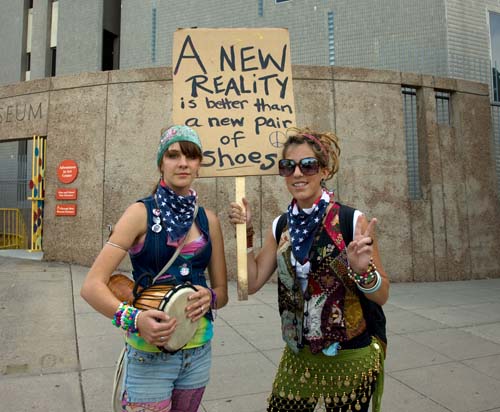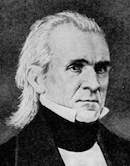History of Party Conventions

Today's pep rallies, yesterday's battlegrounds
by Beth Rowen |
 Protesters Shannon Collins and Olivia Christian at the 2008 Democratic National Convention. Photo by Carol M. Highsmith Related Links President James K. Polk wasn't nominated until the eighth round of the Democratic convention. |
Presidential conventions have come a long way since the days when delegates and party leaders would emerge from smoke-filled rooms, battle weary after hours of negotiating over platforms and presidential nominees.
That's not to say the process has improved. On the contrary, since the dawn of television, the conventions have diminished in importance and are now essentially choreographed, made-for-television events that double as free TV time for candidates. Because the candidates and their running mates are foregone decisions (the conventions serve only to ratify the winner of the primaries, and his or her running mate), the events are widely considered pep rallies for the parties, and not many Americans tune in. Consequently, they're not ratings bonanzas and the networks dedicate only about an hour of airtime to them each night.
Deadlock at 1844 Convention
It hasn't always been like this. In fact, conventions were once lively events. Before the 1960s, the quadrennial gatherings were actually decision-making forums where the delegates met for four days to promote party unity, establish the party platform, vote for a presidential nominee, and then a vice presidential nominee.
Many times delegates could not find consensus on candidates or platform. In 1924, Democrats cast 103 ballots before nominating John W. Davis, and in 1860 Stephen Douglas was finally selected after 59 ballots (and two conventions). Deadlock at the 1844 Democratic convention resulted in the selection of "dark horse" candidate James K. Polk, who was chosen on the ninth ballot, even though he wasn't nominated until the eighth.Breakdown Over Slavery
In some cases, heated factional debates led to the breakdown of the conventions all together. The Democrats were bitterly divided in 1860 over the slavery issue. When delegates adopted Stephen Douglas' plank that supported nonintervention with slavery in the territories, several delegates from the South bolted from the Charleston, South Carolina, convention in protest.
Not enough delegates remained to nominate Douglas, even though he led the race on 57 ballots. (An 1832 rule established by the Democrats required a two-thirds vote for a nomination.) A second gathering was held in Baltimore. This time 110 Southern delegates walked out and nominated their own candidate, John Breckenridge from Kentucky. Illinois' Stephen Douglas finally won the nomination of the "loyalists."
While the early conventions often required more than one ballot, there have been only a handful of times in the past five decades that the conventions were nail-biters. In 1952, Adlai Stevenson triumphed over a "Stop Stevenson" campaign and won the nomination in three ballots. Stevenson created even more drama at the 1956 convention, when he declined to appoint a running mate, and the delegates chose Sen. Estes Kefauver over Sen. John F. Kennedy in two ballots. One of the closest races in recent history saw Gerald Ford edge out Ronald Reagan, 1187–1070.







